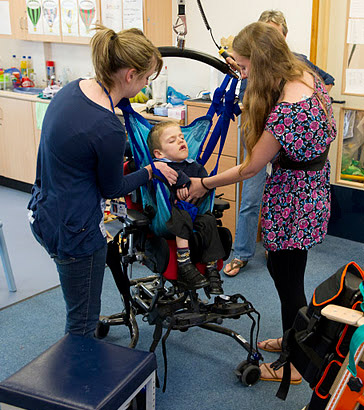
Schools will have a health and safety policy which staff must read and be familiar with. It will include procedures for risk assessment and personal incident reporting.
As an employee you have a duty to:
- Take reasonable care of your own and others' health and safety.
- Co-operate with your employer.
- Carry out activities in accordance with training and instructions.
- Inform your employer of any serious risks.

Currently a child or young person's moving and handling needs, both current and future, are defined in their Statement of Special Educational Need (pending the special education White Paper) to allow adequate planning of provision. Changing needs are documented, in consultation with the child or young person, parent(s)/carer(s) and other relevant staff, during Statement reviews.
When moving and handling children or young people with physical needs:
- The health, safety and dignity of all those concerned is paramount.
- Access to the curriculum, therapies and other school activities is a vital consideration.
Cope, 2010

When moving or handling children or young people with SLD/PMLD/CLDD, to avoid significant risk of injury, schools need to comply with safety law and implement:
- Individual risk assessments – competently assessed, updated annually or as needs change.
- Appropriate equipment – sufficient quality and quantity, maintained and inspected, infection clean, health and safety compliant.
- Training in moving and handling techniques, and use of equipment and pre-use checks.
- Support (including supervision where necessary).
- Identified and agreed safe work systems.
Schools are also required to inform, consult and involve safety representatives and other agencies.
Cope, 2010

Any manual handling injury or accident that occurs at
work must be recorded and reported as soon as possible using the usual Health and Safety accident procedures and forms. Any
required remedial actions to prevent a similar injury or incident must be undertaken immediately or warning signs put in place
to reduce the risk of further incident.
Cope, 2010
The legal duties placed on employees are to:
- Avoid hazardous manual handling operations so far as is reasonably practicable.
- Assess any hazardous operations that cannot be avoided.
- Remove or reduce the risk of injury, using the assessment as a basis for action.
Cope, 2010

The following legislation is relevant to moving and handling children and young people with disabilities:
- Management of Health and Safety at Work regulations 1999 for the provision of safe handling techniques and assessments.
- Provision and Use of Work Equipment Regulations 1998 (PUWER '98).
- Lifting Operations and Lifting Equipment Regulations 1998 (LOLER '98).
- SEN and Disability Act 2001 and Part 4 of the Disability Discrimination Act 2005.

With a colleague, and keeping your current practice in mind, read and reflect on:
- The following two extracts providing guidance about moving and handling:
- Your school's moving and handling policy and school practice.
Write a brief evaluative summary of your own practice in relation to these documents,
and any points for action.

When considering health and safety issues, it is important to access the most up-to-date Health and Safety Executive guidance (http://www.hse.gov.uk/index.htm).
Health and Safety Executive (1998) Moving and Handling in Health and Social Care.
Health and Safety Executive (2006a) Health and safety matters for special educational needs: moving and handling (HSE information sheet). Bootle: HSE
Health and Safety Executive (2006) Health and safety matters for special educational needs: legal issues including risk assessment (HSE information sheet). Bootle: HSE.

Health and Safety Executive (2011) Getting to grips with hoisting people (HSE information sheet). Bootle: HSE.

Department for Education and Skills (DfES) and the Department of Health (2001) Access to Education for Children and Young People with Medical Needs. Annesley: DfES publications.
Ofsted (2003) The Education of Pupils with Medical Needs. London: Ofsted.